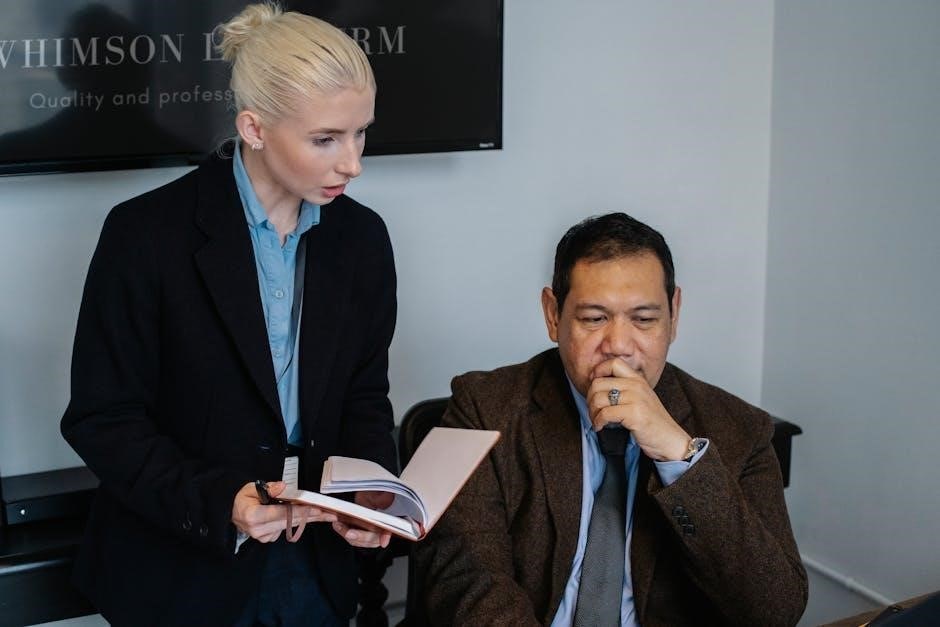John C. Maxwell’s The 21 Irrefutable Laws of Leadership provides a comprehensive guide to essential leadership principles. These timeless laws, derived from Maxwell’s extensive experience, offer practical wisdom for leaders across various fields, helping them inspire and guide teams effectively. This foundational work is a must-read for anyone aspiring to lead with impact and integrity.
Overview of John C. Maxwell’s Leadership Philosophy
John C. Maxwell’s leadership philosophy, outlined in The 21 Irrefutable Laws of Leadership, emphasizes timeless principles that guide effective leadership. Maxwell, a renowned author and speaker, believes leadership is a journey, not a destination. His philosophy centers on empowering others, fostering growth, and creating lasting impact. By combining practical wisdom with real-world examples, Maxwell’s approach equips leaders to inspire and guide teams successfully. His work has become a trusted resource for leaders globally, offering insights that transcend industries and cultures.
The Importance of Understanding Leadership Laws
Understanding leadership laws is crucial for effective leadership, as they provide foundational principles that guide successful leaders. These laws, as outlined in Maxwell’s work, help leaders navigate challenges, build strong teams, and achieve organizational goals. By mastering these laws, leaders can enhance their influence, foster trust, and drive success. Ignoring them often leads to missed opportunities and stagnant growth. Thus, embracing these principles is essential for anyone committed to leadership excellence and lasting impact.
The Law of the Lid
The Law of the Lid states that leadership ability determines a person’s level of effectiveness, acting as a “lid” that caps potential. Strong leadership lifts this lid, enabling greater impact and success for both individuals and teams.
Definition and Significance in Leadership
The Law of the Lid, as defined by John C. Maxwell, posits that leadership ability is the ultimate determinant of personal and organizational success. It serves as a metaphorical “lid” that caps potential, emphasizing that without strong leadership, growth and progress are stifled. This law is significant because it highlights the critical role leaders play in unlocking the full potential of their teams and organizations. By understanding this principle, leaders can focus on developing their skills to raise their lid and achieve greater impact.
How the Law of the Lid Impacts Team Potential
The Law of the Lid directly influences team potential by establishing a ceiling based on the leader’s capabilities. If a leader’s skills are limited, the team’s performance and growth are similarly restricted. Conversely, when leaders invest in self-improvement, they elevate their lid, enabling their teams to achieve higher levels of success. This law underscores the importance of continuous leadership development to maximize team potential and foster a culture of excellence and growth.

The Law of Influence
Influence is the cornerstone of effective leadership, enabling leaders to inspire and guide others toward shared goals. It is the ability to positively impact people’s actions and decisions, fostering collaboration and driving success.
Building Influence as a Leader
Building influence as a leader requires trust, credibility, and a genuine connection with others. It involves understanding people, adding value to their lives, and leading by example. Influential leaders foster collaboration, communicate effectively, and empower others to achieve their potential. By consistently demonstrating integrity, empathy, and a commitment to growth, leaders can cultivate strong relationships and inspire loyalty. Influence is not about control but about positively impacting others and guiding them toward a shared vision. This is the essence of Maxwell’s Law of Influence.
Key Strategies to Enhance Leadership Influence
To enhance leadership influence, focus on developing strong communication skills, actively listening to your team, and leading by example. Build trust by being transparent and consistent in your actions. Empower others by delegating responsibilities and fostering a growth mindset. Cultivate relationships through genuine care and mentorship. Stay adaptable to change and continuously seek opportunities for personal and team development. These strategies, rooted in Maxwell’s principles, help leaders expand their influence and create a lasting impact on their organizations. Effective influence is about inspiring and enabling others to reach their full potential.

The Law of Process
Leadership development is a continuous journey requiring patience, persistence, and dedication. Growth occurs through consistent effort, learning from mistakes, and refining skills over time.
Leadership Development as a Continuous Journey
Leadership development is a continuous journey shaped by experience, learning, and growth. According to Maxwell, it requires patience, persistence, and dedication; Leaders must embrace lifelong learning, understanding that mastery takes time. The Law of Process emphasizes that leadership skills are refined through consistent effort and overcoming challenges. By investing in personal and professional growth, leaders can build a strong foundation for long-term success and lasting impact.
Patience and Persistence in Leadership Growth
Patience and persistence are vital in leadership growth, as development doesn’t happen overnight. Maxwell stresses that leadership skills are cultivated through time, effort, and overcoming challenges. Leaders must remain committed to their journey, embracing setbacks as opportunities to learn. By staying persistent and patient, leaders build resilience and wisdom, essential for guiding teams effectively. This mindset ensures sustainable growth and lasting success in leadership roles.

The Law of Navigation
The Law of Navigation involves guiding teams through challenges. Leaders must have a clear vision, strategic thinking, and strong decision-making skills to ensure success.
Guiding Teams Through Challenges
The Law of Navigation emphasizes a leader’s ability to guide teams through challenges effectively. It requires a clear vision, strategic planning, and execution. Leaders must anticipate obstacles, make informed decisions, and remain calm under pressure to ensure success. This law highlights the importance of experience and intuition in leadership, enabling leaders to steer their teams confidently through uncertain waters. By mastering navigation, leaders foster trust and resilience, essential for overcoming adversity and achieving organizational goals.
Essential Skills for Navigating Organizational Change
Mastering the Law of Navigation requires leaders to possess strong communication, adaptability, and problem-solving skills. They must effectively convey the vision and rationale behind change, fostering alignment and commitment. Flexibility allows leaders to pivot strategies when necessary, while quick decision-making ensures momentum. Building trust through transparency and consistency is crucial. Leaders who excel in these areas can successfully steer their organizations through transitions, ensuring stability and continued progress despite challenges.

The Law of the Inner Circle
The Law of the Inner Circle emphasizes the importance of surrounding yourself with trusted advisors who possess wisdom, experience, and loyalty. This group serves as a sounding board for ideas, providing valuable insights and support, which are essential for making informed decisions and achieving leadership success.
The Role of Trusted Advisors in Leadership
Trusted advisors play a pivotal role in leadership by offering guidance, expertise, and unwavering support. They provide diverse perspectives, challenge assumptions, and help leaders make informed decisions. These individuals, chosen for their wisdom and integrity, foster a culture of accountability and collaboration. Their insights enable leaders to navigate complex challenges effectively, ensuring alignment with organizational goals and values. A strong inner circle of trusted advisors is indispensable for achieving sustainable success and maintaining high standards of leadership excellence.
Building a Strong and Reliable Team
Building a strong and reliable team requires intentional effort and a clear vision. Leaders must identify and recruit individuals with complementary skills and shared values. Fostering trust, open communication, and collaboration creates a cohesive unit. Empowering team members through delegation and development ensures they reach their full potential. A well-rounded team, supported by effective leadership, becomes a driving force for organizational success and resilience in overcoming challenges.
The Law of Empowerment
Empowerment involves trusting and equipping others to take ownership of their work, fostering growth and accountability. It transforms individuals into capable leaders, driving collective success.
Empowering Others to Achieve Success
Empowering others involves granting authority, sharing knowledge, and fostering confidence. This law emphasizes that leaders must trust their team members to handle responsibilities effectively. By delegating tasks and providing support, leaders enable individuals to grow and excel, which ultimately strengthens the organization. Maxwell highlights that empowerment is not just about assigning work but also about creating an environment where people feel valued and capable of achieving their full potential.
Creating an Environment of Trust and Delegation
A culture of trust and delegation is crucial for effective leadership. Leaders must trust their team members to handle responsibilities and delegate tasks confidently. This fosters accountability and growth, allowing individuals to take ownership of their work. By empowering others, leaders create a supportive environment where trust flourishes, and collaboration thrives. Maxwell emphasizes that delegation is not just about assigning tasks but about believing in people’s abilities and providing the necessary resources for their success.
The Law of the Picture
Leaders must lead by example, as people follow what they see, not just what they hear. Consistency between words and actions is vital for credibility and trust.
Leading by Example and Modeling Behavior
Leading by example is the cornerstone of effective leadership. A leader’s actions speak louder than words, setting the standard for their team. By modeling the behavior they expect, leaders create a clear vision and inspire others to emulate their conduct. This consistency between words and actions builds trust and credibility, fostering a culture of accountability. When leaders lead by example, they demonstrate their commitment to the team’s success, making their vision tangible and achievable. This principle is foundational to lasting leadership impact.
Consistency Between Words and Actions
Consistency between words and actions is vital for building trust and credibility. Leaders who align their behavior with their speech demonstrate integrity, which strengthens their influence. When actions consistently reflect stated values, team members are more likely to follow and respect their leader. This alignment fosters a culture of trust and reliability, essential for effective leadership. Maxwell emphasizes that true leadership is not about rhetoric but about living out one’s commitments, ensuring that actions reinforce and validate their words.
The Law of Buy-In
The Law of Buy-In emphasizes gaining commitment from team members to achieve shared goals. It highlights the importance of engagement and belief in the vision, fostering unity and purpose within the team.
Gaining Commitment from Team Members
Gaining commitment from team members is essential for effective leadership. It involves inspiring trust, aligning goals, and fostering a sense of ownership. When leaders communicate clearly and demonstrate belief in their vision, team members are more likely to invest their energy and dedication. This mutual commitment strengthens relationships, enhances collaboration, and drives collective success, ensuring that everyone works toward a common purpose with enthusiasm and accountability.
Strategies to Increase Team Engagement
Increasing team engagement requires intentional leadership actions. Leaders should foster a clear vision, recognize individual contributions, and empower team members to take ownership. Encouraging open communication, providing growth opportunities, and celebrating achievements can significantly boost morale. Creating a positive work culture where everyone feels valued and heard ensures higher levels of commitment and productivity. These strategies, rooted in Maxwell’s laws, help leaders build a motivated and dedicated team ready to achieve organizational goals collectively.

The Law of Victory
The Law of Victory emphasizes creating an environment where team success is achievable. Leaders must align efforts, clarify goals, and ensure everyone contributes to shared objectives effectively.
Creating an Environment for Success
According to Maxwell, fostering a culture of success involves clear communication, alignment of team efforts, and providing necessary resources. Leaders must define objectives, empower individuals, and promote collaboration. By ensuring each team member understands their role and how it contributes to the broader vision, leaders set the stage for collective achievement. This approach not only enhances productivity but also builds morale and commitment within the organization, driving sustainable success.
Aligning Team Efforts with Organizational Goals
Maxwell emphasizes that aligning team efforts with organizational goals ensures unity and purpose. Leaders must clearly communicate the vision and ensure each member understands their role in achieving it; When everyone works toward the same objectives, collective impact is maximized. This alignment fosters accountability, streamlines processes, and strengthens the organization’s ability to reach its full potential. Effective leaders prioritize goal clarity and ensure that individual and team efforts are synchronized with the broader mission.
Harnessing the Power of Momentum
The Law of the Big Mo highlights the importance of momentum in leadership. Momentum builds confidence, accelerates progress, and helps teams achieve their goals more effectively.
Momentum is a powerful force that propels teams toward success. Leaders must recognize and leverage it to drive progress. Momentum builds confidence, accelerates goal achievement, and fosters a culture of continuous improvement. It is the leader’s responsibility to create and maintain momentum, ensuring that the team remains focused and motivated. Without momentum, even the most well-planned strategies can stagnate. Effective leaders understand how to initiate and sustain momentum, leading to sustained growth and achievement of organizational objectives.
Strategies to Maintain and Build Momentum
Building momentum requires intentional actions. Leaders should set clear, achievable goals to maintain progress. Celebrating small wins motivates teams and sustains energy. Consistent communication and transparent feedback are essential to keep everyone aligned. Encouraging a growth mindset fosters resilience and adaptability. Leaders must also eliminate obstacles and provide necessary resources. By creating a positive environment and recognizing efforts, leaders can maintain and amplify momentum, driving their teams toward long-term success and organizational excellence. Momentum is a leader’s most powerful ally for achieving lasting impact.

Practical Applications of the 21 Laws
The 21 Irrefutable Laws of Leadership offer real-world strategies for leaders to enhance their skills. By applying these principles, leaders can solve problems, build strong teams, and drive success in various industries. The laws provide actionable insights, making them invaluable for leadership development and everyday challenges. Leaders can use these laws to create positive change and achieve lasting impact in their organizations. Practical application ensures sustained growth and effectiveness.
Implementing the Laws in Real-World Scenarios
Implementing the 21 Irrefutable Laws of Leadership involves applying timeless principles to everyday challenges. Leaders can use the Law of the Lid to assess their leadership capacity and improve team performance. The Law of Influence helps build trust and credibility, essential for guiding teams through change. By integrating these laws into decision-making and communication, leaders can create environments where teams thrive. Real-world application ensures these principles become practical tools for achieving organizational goals and fostering growth. Effective implementation transforms leadership theory into actionable success. Momentum builds as leaders consistently apply these laws, driving long-term results and sustained impact.
Case Studies of Successful Leadership
Case studies highlight how leaders have successfully applied the 21 Irrefutable Laws of Leadership. For instance, the Law of the Lid has helped organizations identify leadership gaps, while the Law of Influence has enabled leaders to inspire and motivate teams. Real-world examples, such as companies implementing the Law of Empowerment, demonstrate how delegating authority fosters growth and trust. These case studies illustrate the practical impact of Maxwell’s laws, showing how they drive organizational success and transform leadership practices. They serve as powerful reminders of the laws’ relevance and effectiveness in achieving lasting results.

Downloading the 21 Laws of Leadership PDF
The 21 Irrefutable Laws of Leadership PDF is available for free on platforms like Open Library and Scribd. It offers insights into Maxwell’s proven leadership principles, providing practical guidance for leaders to enhance their skills and inspire their teams effectively. The PDF includes key strategies, real-world examples, and actionable advice, making it an invaluable resource for leadership development. Download now and start transforming your leadership journey.
Reliable Platforms for Free PDF Downloads
Platforms like Open Library, Scribd, and PDF Drive offer free downloads of The 21 Irrefutable Laws of Leadership PDF. These sites provide legal access to the book, ensuring high-quality content. Users can also explore Google Books for preview snippets. Always verify the authenticity of the PDF to ensure a safe and complete download. These platforms are trusted sources for accessing Maxwell’s timeless leadership insights without cost, making them ideal for leaders seeking to enhance their skills.
Key Features of the PDF Edition
The PDF edition of The 21 Irrefutable Laws of Leadership includes revised content, charts, and a growth guide. It offers a clear, structured format, making it easy to navigate. The digital version is accessible on various devices, providing convenience for readers. Enhanced with practical tools, the PDF ensures a comprehensive learning experience, helping leaders apply Maxwell’s principles effectively in real-world scenarios. This edition is a valuable resource for both personal and professional development.
The 21 Irrefutable Laws of Leadership by John C. Maxwell offers timeless wisdom, empowering leaders to inspire and guide effectively. Apply these laws daily to achieve lasting impact.
Final Thoughts on the 21 Laws of Leadership
John C. Maxwell’s 21 Irrefutable Laws of Leadership remains a cornerstone of leadership development. These principles, refined over decades, offer clear guidance for fostering growth, building strong teams, and achieving organizational success. By embracing these laws, leaders can unlock their full potential and create a lasting legacy. The PDF edition provides accessible, practical insights, making it an invaluable resource for leaders at every level.
Encouragement to Apply the Laws in Daily Leadership
Applying the 21 Irrefutable Laws of Leadership in daily practice transforms leaders and their organizations. Start by identifying areas for personal growth, then implement the laws incrementally. Surround yourself with a strong inner circle, empower your team, and lead by example. The PDF edition offers a convenient reference for inspiration and guidance. Remember, leadership is a journey, not a destination—commit to continuous improvement and watch your impact grow.

Leave a Reply
You must be logged in to post a comment.